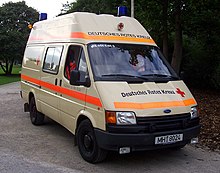4-stretcher ambulance
|
4-stretcher ambulance |
|
|---|---|
| Vehicle data
|
|
| Abbreviation: | 4-stretcher KTW |
| Country: | Germany |
| Crew: | originally: 1 squad leader or 1 squad leader or 1 paramedic 1 driver today: different from region to region |
| Commitment: | Ambulance transport, care |
| Furnishing: | STAN of the federal government |
| Speed: | 113 - 155 km / h (depending on the model) |
| Perm. Total weight : | varies between 2.6 tons and 3.5 tons of kilograms depending on the variant |
| Drive: | Road (rear axle drive) |
The 4-stretcher ambulance is a vehicle used by the medical service in disaster control in Germany . It is no longer delivered nationwide, but is still widely used.
The army also used vehicles for four lying injured, in which case the term ambulances (KrKw) applies. The Bundeswehr differentiates between commercial (HÜ) and all-terrain (GL).
Abbreviations
The Federal Office for Civil Protection (today: Federal Office for Civil Protection and Disaster Assistance ), which originally procured and equipped it, only specified “KTW” as an abbreviation . To distinguish it from ambulances of the regular qualified ambulance, the abbreviations "4-stretchers-KTW" are used in common parlance.
standardization
The 4-stretcher ambulance is not standardized, but there is a federal strength and equipment certificate (STAN). The equipment then also corresponded to DIN 75 080. As long as the vehicle is still being run as a federal vehicle, the equipment according to the federal STAN must be kept as a minimum.
In the vehicle there are two support frames on the left and right on the wall, on which two patients can be placed on top of each other. The carrying devices can be folded up so that a flat and large loading area is created. In addition, with older vehicle models and the Bundeswehr KrKw, the carrying frames can be partially converted into seating, so that up to 6 slightly injured people can be transported in a space-saving manner.
tasks
The ambulance is used to transport up to four injured or sick people to stationary care facilities under medical care. In addition to pure transport, medical support for other areas of responsibility (such as care and decontamination ) and first aid for injured persons can also be provided.
units
The 4-stretcher ambulance originally belonged to the injured transport group of the ambulance train (STAN No. 041), which consisted of four 4-stretcher ambulances. The total of eight emergency services consisted of a group leader, a squad leader, two paramedics and four drivers (one KTW each with a group leader and driver, a KTW with a squad leader and driver and two ambulances each with a paramedic and a driver).
The existing vehicles were following the abolition of uniform national guidelines for the civil protection features different uses in the newly established units such as operational units and fast-groups , respectively.
history
Five different types of 4-stretcher ambulances were procured by the federal government. In 1980, 1984 and 1991 vehicles based on different series of Ford Transit were procured. A prototype based on a Mercedes-Benz T 1 was also built in 1984. There was also a federal procurement after 1999 on a Mercedes-Benz Sprinter basis. This was the last series of acquisitions for this vehicle type.
Some districts and federal states have also procured 4-stretcher ambulances for disaster control. In Schleswig-Holstein, for example, vehicles based on Mercedes-Benz Sprinter and VW Crafter were procured in 2008 .
successor
As part of the establishment of Medical Task Forces , the federal government is procuring emergency ambulances with two stretchers as additional equipment for disaster control .
Web links
Individual evidence
- ↑ a b c d BVA: Data sheet for ambulances BA no. u. a. 1025/80.
- ↑ a b c d BVA: Data sheet for ambulances BA no. u. a. 1002/84.
- ↑ a b c d BVA: Data sheet for ambulances BA no. 1107/84.
- ↑ a b c d BVA: Data sheet for ambulances BA no. 1019/91.
- ↑ a b c d BVA: Data sheet for ambulances BA no. 1011/99.
- ↑ a b BBK / BZS: Sanitätsdienst (SanDi) in disaster control. Medical train strength and equipment certificate (SZ). STAN no. 041. As of May 1984.
- ↑ Information on kfv-rdeck.de. ( Memento from March 4, 2016 in the Internet Archive )



